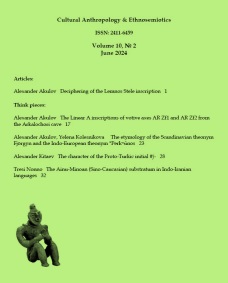Articles
Deciphering of the Lemnos Stele inscription
Alexander Akulov
The Lemos Stele is a funerary monument with an inscription in the Lemnian language, that is a juncture between Etruscan and Hurro-Urartian. The inscription of side A tells about Holaie’s grandson/nephew named Zia: Holaie-z(1) nafoth(2) Zia-zi(3) mara-z(4) maw(5). Sialkʰweiz(6) awiz(7) Ewistho(8) zeronaith(9) ziwai(10). Aker(11) tawar-zio(12) Wamala-si-al(13) zeronai(14) Morinai-l(15). Holaie’s(1) grandson/nephew(2) Zia(3) served(5) as maru(4). Died(10) [at the age of] forty(6) years(7) [in the] shrine(9) [of] Hephaestus(8). Buried(12) [in] June(11) [in the] shrine(14) of Wamala(13), in Myrina(15). And the text of side B tells about Holaie: Holaie-zi(1) Phokia-si-al-e(2) zer-ona-ith(3) Ewistho(4) tower-ona-r-om(5) hara-lio(6) ziwai(7). Epte-zio(8) arai(9). Tiz(10) Phoke(11) … ziwai(12) awiz(13) sialkʰwiz(14); mara-z-m(15) awiz(16) aomai(17). Holaie(1) lived(7) ruling(6) the members of the chamber of judge(5) of Hephaestus(4) in the sacral place(3) of Phocaea(2). Being a leader(8) [he] actively acted/performed rituals(9). [For] forty(14) years(13) [he] lived(12) in the bay(10) of Phocaea(11); and also some(17) years(16) [held] the position of maru(15).
Keywords: Lemnos Stele; Tyrrhenian languages; Etruscan language; deciphering of writing systems
Think pieces
The Linear A inscriptions of votive axes AR Zf1 and AR Zf2 from the Arkalochori cave
Alexander Akulov
Two votive axes from the Arkalochori cave (AR Zf1, AR Zf2) have completely identical inscription consisting of four Linear A signs: AB28, AB01, AB80, AB04. The inscription is read from left to right and from right to left. When the inscription is read from left to right, we receive the first part: Ida-mate – “Mother Ida”: mate – “mother” is a borrowing from Mycenaean, Ida means “the large/sublime”, Ida is a name of the tutelary deity of the corresponding mount. When the inscription is read from right, we receive the second part: te-ma-da-i, that is a verb: te– is a marker of optative, –ma– – a marker of patient, da – the root “to help”, –i – a marker of tense/aspect. Being joined together, both parts give the following: Ida-mate te-ma-da-i “May the Mother Ida help me/us”. Such an unusual form of recording is due to the ritual nature of the object.
Keywords: Minoan language; Linear A; Hattic language; Mycenaean language; Arkalochori cave; Minoan religion
The etymology of the Scandinavian theonym Fjörgyn andthe Indo-European theonym *Perkʷūnos
Alexander Akulov, Yelena Kolesnikova
The etymology of the Indo-European theonym Perkwūnos is unclear, as well as that of the Scandinavian theonym Fjörgyn. In the Yeniseian mythology there is a being named fɯrgɯnj “forest spirit / witch” (fɯrgɯnjß *pǝ(ʔ)r-qVn ß *pǝ(ʔ)r “woody hill” + qVm “woman”).The name Fjörgyn and the word fɯrgɯnj look much alike, but Fjörgyn has no evident inner structure, while fɯrgɯnj has. The name Fjörgyn seems to be nothing else, but the Yeniseain word fɯrgɯnj in its Scandinavian form. The form *pǝ(ʔ)r-qVn is present in the word *Perkʷūnos, the only difference is the ending –os. The Indo-Europeans borrowed the theonym *Pǝ(ʔ)r-qVn from the Yeniseans, in Proto-Indo-European this theonym became *Perkwun. And the name of the spouse of *Perkwun was just an Indo-European genitive of the name *Perkwun (the ending –os is a standard Proto-Indo-European genitive marker), so *Perkʷūnos initially meant “of Perkwun”.
Keywords: Proto-Indo-European language; Yeniseian languages; Perkwūnos; Fjörgyn; fɯrgɯnj
Akulov_Kolesnikova_Perkwunos_Fjorgyn
The character of the Proto-Turkic initial #j–
Alexander Kitaev
The question of the character of the initial Proto-Turkic #j- is one of the most debatable. Some scholars interpret it as a normal, typical sonorant, others raise objections and reconstruct it as an explosive or affricative (#ȝ- or #ǯ-). Both points of view have strengths and weaknesses and principally are equivalent; both types of change (#j- à #ȝ- / #ǯ- or #ȝ- / #ǯ à #j) are of the same force. Thus, the result of the argument based on the comparison of various common Turkic branches is a draw game. Only Chuvash data show us the interpretation of this sound as an explosive or affricative is more likely.
Keywords: comparative linguistics; Turkic languages; Chuvash language; proto-Turkic #j-; methodology of science
The Ainu-Minoan (Sino-Caucasian) substratum in Indo-Iranian languages
Tresi Nonno
In Sanskrit and in Iranian languages there are about 55 words that have no reliable Indo-European etymology, but are supposed to have originated from the language of the Bactria-Margiana Archaeological Complex (BMAC). The BMAC language seems to be quite close to Burushaski and Yeniseian. Burushaski and Yeniseian languages are quite close relatives, and both belong to the Ainu-Minoan stock / macrofamily. At least some of these 55 substratum words can be correlated with Burushaski and Yeniseian words. The most notorious examples are: the Sanskrit word atharvan – a legendary priest who, according to Hinduism, performed the first yajna – originally was the following word-form: a-th-a-r-u-an – “the one who performs rite”; the Sanskrit theonym Indra correlates with the Proto-Yeniseian form *tɨŋgVr “high”; the Sanskrit word nagnáhu “sourdough” and Persian nān “bread” correlate with Common Burushaski *naɣé “dung” (sourdough sometimes does not smell particularly pleasant and is similar in consistency to the dung).
Keywords: substratum in Sanskrit; Burushaski language; Yeniseian languages; Bactria Margiana Archaeological Complex; Ainu-Minoan stock; Sino-Caucasian stock
